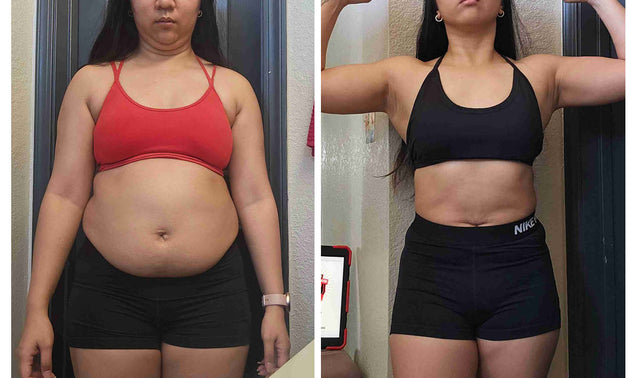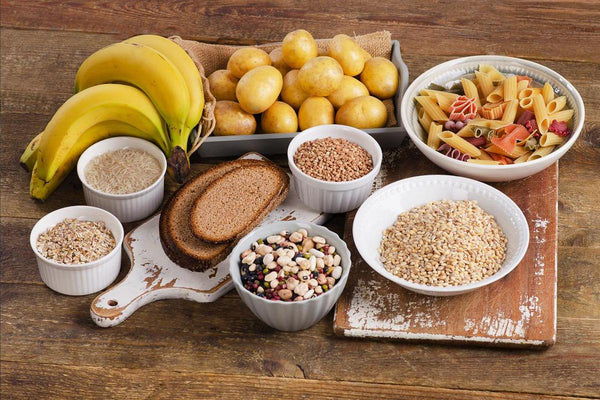What is a Carb Cycling Diet?
As you can guess from the name, a carb cycling diet is a nutritional approach where you alternate your carbohydrate intake from one day to the next.
Generally speaking, you will place your higher carb days on days where are you are most active (or have your hardest workouts), or the day before an intense workout, so as to ensure that glycogen stores are fully topped off.
By that logic, your low and/or moderate carb days will generally coincide with the days that you are less active or resting completely.
Protein and fat remain relatively constant each day of the week.
However, the fat content may increase on the low carb days depending on what your goals are with following a carb cycling diet.
That brings us to the next point.
Why Would I Want to Follow a Carb Cycling Diet?
For the average person looking to drop a few pounds, build some muscle, and improve their body composition, following a carb cycling diet likely is unnecessary.
The reason for this is that carb cycling is an advanced nutritional strategy typically used by elite physique competitors to get down to stage-levels of leanness.
You see, when you diet for prolonged periods of time, the body will eventually adapt to the reduced calorie diet, which means fat loss will stall.
In an effort to prevent plateaus, as well as have to avoid further reducing calories or increasing energy intake, individuals will try to cycle their carbohydrates (and by default, calories) to keep their body’s from adapting to a set level of calorie intake.
Another reason an individual may choose to follow a carb cycling diet is to improve their metabolic flexibility.
For those of you that may not know, “metabolic flexibility” refers to an individual’s ability to adapt and respond to alterations in fuel substrates.[1]
In other words, if an individual is metabolically “flexible”, then they can equally well handle using glucose or fat for fuel as well as ingesting both macronutrients.
Since carb cycling diets alternate between low carbohydrate and high carbohydrate days, you essentially “force” your body to burn a higher percentage of energy from fat on the low carb days.
Conversely, on higher carb days, the body will burn a higher percentage of carbohydrates for energy.
What Foods Can I Eat on a Carb Cycling Diet?
One of the benefits of the carb cycling diet is that no food (or food group) is off limits.
You can eat any food that you desire, so long as you stick to your calorie and macronutrient limits for the day.
That means all manner of cakes, cookies, pop tarts, pastries, pizza, and even alcohol are allowed, so long as you keep to the macronutrient goals you’ve set for a given day.
How Do I Set Up a Carb Cycling Diet?
There are multiple ways to set up a carb cycling diet, and no two diets will necessarily be the same.
For example, the carb cycling diet for an individual looking to lose fat may be significantly different from that of an individual looking to build muscle or recomp.
The reason for this all boils down to energy balance.
Individuals looking to lose body fat will likely keep their fat and protein macros the same regardless of high carb or low carb days, whereas individuals looking to gain weight (i.e. build muscle) will increase their fat intake to account for the low carbohydrate intake so that they remain either in a positive energy balance or in a eucaloric state (maintenance calories).
For simplicity’s sake, let’s assume you’re interested in losing fat.
In order to set up a carb cycling diet for weight loss, here’s how you may want to set up your week:
First, calculate how many calories you need to lose weight.
If you need help figuring out how many calories you need to eat to lose weight, click here.
- Protein: 1 gram per pound (regardless if it is a high-carb or low-carb day)
-
Carbohydrates:
- High carb days = 40-50% of your calories from carbs
- Low carb days = 20-25% of your calories from carbs
- Fat: remainder of calories after subtracting for protein and carbs
As a general rule (as mentioned above), it’s recommended to place your high-carb days on your hardest workout days (legs and back, for instance) or the day prior to those workouts, to ensure glycogen stores are full and you have sufficient energy to perform in your workouts.
For example, if you train legs on Tuesday and Friday, you will want to place your high carb days on Tuesday and Friday, or possibly Monday and Thursday, if you train immediately upon waking.
Now, for low-carb days, you’ll likely want to consume the majority of your carbohydrates before and after training, as this will help support performance and promote recovery after training.
At this point, it bears mentioning that “low carb” days are not the same thing as “no carb” days.
You can still eat fibrous veggies (broccoli, kale, spinach, chard, etc.) and some fruit (mostly berries) on low carb days.
However, you will likely need to limit your intake of starchy carbohydrates, such as bread, rice, pasta, potatoes, and sweet potatoes in order to stick to your calorie and macro targets.
At the same time, high-carb days are not an excuse to go on pop tart, doughnut, and buffet benders. You still need to focus the majority of your calories on whole, minimally processed foods to make sure you’re getting enough micronutrients and fiber.
The benefit of high carb days is that you can squeeze in more starchy foods like rice, pasta, or the occasional slice of pizza without blowing you diet for the day.
Benefits of Carb Cycling Diets
Carb cycling diets, by and large, have not been extensively studied by the research community. Predominantly, they are used by physique athletes to break a weight loss plateau or prevent the bodies from adapting to the rigors induced by aggressive diets.
That being said, we can glean some potential benefits of carb cycling from an understanding of the human body’s inner workings.
Beginning with the low carb days, when you consume lower amounts of carbohydrates, there is less insulin released, which promotes fat burning and also supports greater insulin sensitivity.
Several studies have shown that low carb diets support improvements in reducing insulin levels and blood glucose levels, espeically in obese individuals and Type 2 diabetics.[2,3]
The benefits of high carbohydrates days (as we’ve mentioned above) primarily exist to replenish glycogen stores (depleted during low carb days), fuel workout performance, and help prevent the body from adapting to prolonged caloric deficits.
Furthermore, consuming higher amounts of carbohydrates also increases levels of insulin released.
Insulin is the primary nutrient shuttling hormone in the body that facilitates the uptake of glucose and amino acids into skeletal muscle. Why this is noteworthy is that insulin exerts anti-catabolic properties, meaning it helps prevent muscle protein breakdown, and it’s also associated with greater muscle protein synthesis -- the biological process that fuels muscle recovery and growth.[4]
Finally, high carb days may also help enhance the function of two hormones that have a considerable impact on hunger and satiety -- ghrelin and leptin.[5,6]
As we’ve mentioned prior, dieting for prolonged periods of time forces the body to adapt, and in doing so it alters levels of hormones that impact how full you feel after eating as well as how hungry you feel.
The theory behind carb cycling diets is that the high carb days give the body a break for prolonged calorie deficits, which “should” help reset ghrelin and leptin levels so that you’re not constantly fending off feelings of hunger while dieting.
This is backed predominantly by anecdotal reports, but needs further validation from the scientific community.
Do I Need a Carb Cycling Diet to Lose Weight?
In a word, no. You do not “need” to cycle your carbohydrate intake during the week in order to lose weight.
Can you follow a carb cycling diet and lose weight?
Absolutely.
But, by no means is it “required” or “necessary” in order to lose weight.
Any diet that places you in an energy deficit (calories in < calories out) will help you lose weight, regardless of which foods you eat, or what time of day you eat.
Fans of low-carb diets proponents will promote a handful of studies that indicate that high-fat, low carb diets are superior to higher carb, lower fat diets for weight loss.[7,8,9]
However, these studies last a relatively short amount of time, and the reason for the weight discrepancy is largely due to the loss of water weight.
It also bears mentioning that low-carb diets also tend to contain greater amounts of protein than high carb, low fat diets in research studies, which makes them more satiating and also helps preserve lean mass more than high carb diets that are deficient in protein.
However, studies that control for protein (meaning that both low-carb and high-carb dieters consume the same amount of dietary protein each day), researchers found no significant difference in terms of long-term fat loss.[10,11]
All of this is to drive home the point that a carb cycling diet can be used for weight loss, but by no means is it needed to lose weight for the average person.
Takeaway
A carb cycling diet is one in which you alternate between days of higher carb intake interspersed with days of low to moderate carb intake while keeping protein intake the same from one day to the next.
Carb cycling is an advanced nutritional protocol best used for short periods of time and by those looking to break plateaus or getting ready for a physique competition.
More research is needed to see if carb cycling really does offer any additional benefits beyond a continuous calorie restriction (i.e. standard dieting).
Rather than always eat low carb or high carb, it may be best to employ a more “moderate” approach to dieting, especially for those only looking to drop a couple of pounds.
Below are a couple of examples of a Carb Cycle Week:

References
- Goodpaster BH, Sparks LM. Metabolic Flexibility in Health and Disease. Cell Metab. 2017;25(5):1027–1036. doi:10.1016/j.cmet.2017.04.015
- Krebs, J. D., Bell, D., Hall, R., Parry-Strong, A., Docherty, P. D., Clarke, K., & Chase, J. G. (2013). Improvements in glucose metabolism and insulin sensitivity with a low-carbohydrate diet in obese patients with type 2 diabetes. Journal of the American College of Nutrition, 32(1), 11–17. https://doi.org/10.1080/07315724.2013.767630
- Tay, J., Luscombe-Marsh, N. D., Thompson, C. H., Noakes, M., Buckley, J. D., Wittert, G. A., … Brinkworth, G. D. (2015). Comparison of low- and high-carbohydrate diets for type 2 diabetes management: a randomized trial. The American Journal of Clinical Nutrition, 102(4), 780–790. https://doi.org/10.3945/ajcn.115.112581
- Fujita S, Rasmussen BB, Cadenas JG, Grady JJ, Volpi E. Effect of insulin on human skeletal muscle protein synthesis is modulated by insulin-induced changes in muscle blood flow and amino acid availability. Am J Physiol Endocrinol Metab. 2006;291(4):E745–E754. doi:10.1152/ajpendo.00271.2005
- Dirlewanger, M., di Vetta, V., Guenat, E., Battilana, P., Seematter, G., Schneiter, P., … Tappy, L. (2000). Effects of short-term carbohydrate or fat overfeeding on energy expenditure and plasma leptin concentrations in healthy female subjects. International Journal of Obesity and Related Metabolic Disorders : Journal of the International Association for the Study of Obesity, 24(11), 1413–1418.
- Poehlman, E. T., Tremblay, A., Fontaine, E., Despres, J. P., Nadeau, A., Dussault, J., & Bouchard, C. (1986). Genotype dependency of the thermic effect of a meal and associated hormonal changes following short-term overfeeding. Metabolism: Clinical and Experimental, 35(1), 30–36.
- Yancy, W. S. J., Olsen, M. K., Guyton, J. R., Bakst, R. P., & Westman, E. C. (2004). A low-carbohydrate, ketogenic diet versus a low-fat diet to treat obesity and hyperlipidemia: a randomized, controlled trial. Annals of Internal Medicine, 140(10), 769–777.
- Volek J, Sharman M, Gómez A, et al. Comparison of energy-restricted very low-carbohydrate and low-fat diets on weight loss and body composition in overweight men and women. Nutr Metab (Lond). 2004;1(1):13. Published 2004 Nov 8. doi:10.1186/1743-7075-1-13
- Samaha, F. F., Iqbal, N., Seshadri, P., Chicano, K. L., Daily, D. A., McGrory, J., … Stern, L. (2003). A Low-Carbohydrate as Compared with a Low-Fat Diet in Severe Obesity. New England Journal of Medicine, 348(21), 2074–2081. https://doi.org/10.1056/NEJMoa022637
- Hall KD, Bemis T, Brychta R, et al. Calorie for Calorie, Dietary Fat Restriction Results in More Body Fat Loss than Carbohydrate Restriction in People with Obesity. Cell Metab. 2015;22(3):427–436. doi:10.1016/j.cmet.2015.07.021
- Thomson, C. A., Stopeck, A. T., Bea, J. W., Cussler, E., Nardi, E., Frey, G., & Thompson, P. A. (2010). Changes in body weight and metabolic indexes in overweight breast cancer survivors enrolled in a randomized trial of low-fat vs. reduced carbohydrate diets. Nutrition and Cancer, 62(8), 1142–1152. https://doi.org/10.1080/01635581.2010.513803






